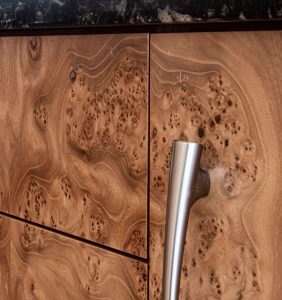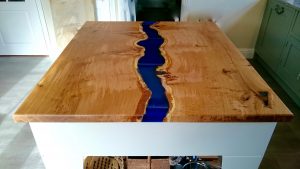An Interview with Andrew Parsley: Founder and Managing Director of Back to Basics
In 1996, a keen young cabinet maker set up his own company hand-building bespoke kitchens and one-off furniture from his Dad’s garage. ‘Back to Basics’ was born! Read on to find out more from the man himself.
Hi Andrew! Tell us a bit more about why you set up Back to Basics…
It all started from getting a lot of requests from friends to build them kitchens, plus like a lot of creative people, I didn’t like being told what to do and wanted to be my own boss! I come from a family of entrepreneurs so setting up on my own company seemed quite natural to me, even though I was quite young. At 27 I started in my Dad’s garage before moving into a workshop in Old Portsmouth – it was on the third floor, so not ideal for building furniture as all the materials had to be winched all the way up to me through trapdoors in the floorboards!
What’s your company ethos?
I love making furniture, and I love seeing people’s reactions when their dream of a new kitchen becomes a reality. To be honest, I have never considered myself to be a ‘businessman’ in the traditional sense – I’ve never been out to be the next Richard Branson… as long as I can earn a living doing what I love, then that’s fine by me. I think that’s something clients like about working with me on their projects. It’s all about the craft.
Can you remember your earliest memory of working with wood?
I must have been about nine or ten and used to sneak into my Grandad’s shed which was full of old furniture. He used to make things out of old chests of drawers and broken up stuff – you could say he was an original up-cycler! I loved it in there because it was messy and homely and interesting.
What was the first wooden thing you made?
A magazine rack at school in woodwork class aged about 14. They were the only lessons I ever enjoyed at school, that and technical drawing, although I was much better at woodwork – it’s the only thing I’ve ever wanted to do.
Being a cabinet maker might seem like quite an old fashioned profession, especially for someone in their 20s, what made you want to be one?
I started my training in woodwork at a furniture maker that was more of a mass-produced joinery company, but I soon realised that I wanted to craft pieces using traditional methods and materials rather than knock up bog standard cupboards and wardrobes out of pine, and luckily I found I was really good at it! I have a real respect for the past and honouring all that wisdom that’s been passed down – flat-pack, assembly-line style furniture erases all that in favour of cheap efficiency (or in other words big profits).
What inspires you?
Seeing the work of other people at the top of their game is a big source of inspiration for me. Instagram and YouTube are great for that, I follow some amazing people. I also love antique furniture and furniture from other cultures – seeing how they are made and the precision and craftsmanship that goes into them. Then I try things out myself and see what happens. A couple of years back I went to the ‘Plywood: Material of the Modern World’ exhibition at the V&A in London – some of the classic furniture there was amazing!
How does a small company like yours compete with the giants in the retail parks?
Great question! It’s tough. But there will always be a demand for something unique I think, made by someone the client trusts. I think people like the fact that it’s me making their kitchen from beginning to end – most people have one hand-built kitchen in their whole lifetime, it’s a big deal! But even though the big companies can buy materials at a fraction of what they cost me, they can never offer what I can, which is truly personal service and a real bespoke product. I’m also able to keep my prices competitive because my workshop is on a rural estate with low overheads, so that helps.
A lot of small businesses have been really struggling during the Covid-19 crisis. How have you been coping?
I’ve been busy actually! I’ve used the time to freshen up the little demonstration space at the workshop, and have a good clear-out and tidy-up. Thankfully I had just finished fitting a big kitchen at the start of lockdown and had a couple of smaller jobs already booked in so have been able to survive financially. I know others haven’t been so lucky. We had a new website launch about 3 weeks before lockdown and I’m pleased to see that enquiries for work are now coming in again – people are itching to get on with their projects and get back to normal – well, the ‘new normal’ anyway.
Do you have a favourite style/ period of furniture?
Yes, Art Deco. I love how geometric shapes are set against curves in the design of pieces from that time, and how they use burr veneers. I try to use them as often as I can in my customer’s commissions. I also enjoy renovating and upcycling mid-century British furniture – much like my Grandad, come to think of it!
What’s been your favourite commission to date and why?
That’s a big ask, for nearly 25 years of work… But I think it’s actually quite a recent piece that we called ‘River Island’. A client had an old cast iron saw bench that had belonged to her Dad and she wanted to repurpose it as a kitchen island. I cleaned up and painted the base, and then designed a solid ‘live-edge’ oak top for it with a blue resin ‘river’ running down its length. We were both so pleased with how it turned out as it was the first resin piece I’d made. I was very grateful to her for having the creative vision to work with me on it. I love it when clients are willing to experiment a bit and I get to make unusual things.
Can you describe your approach to furniture building?
That needs to be made properly and last a lifetime. Although there are fashions in furniture styles, good design is timeless and the build quality needs to match that. I’m a bit of a perfectionist really – but when you are making things to fit exactly that’s quite a good trait to have, I think. I like to make furniture that looks as if it’s always been there, part of the fabric of the building. But I also love combining traditional styles with modern touches too, like the ‘river island’ I talked about just now.
What’s next for Back to Basics?
As well as carrying on with the traditional-style fitted kitchens, I’m really looking forward to making the most of the trend towards stand-alone kitchen furniture. I’ve bought a few vintage pieces recently that I’m working on converting into funky larder cupboards and drinks cabinets. With open-plan living all the rage, people don’t want their kitchen area to look like it’s just been plonked in the corner of a big room, so there’s loads of exciting scope for new types of hybrid furniture that are beautiful as well as functional. You can see these projects as they happen on our Instagram feed.




